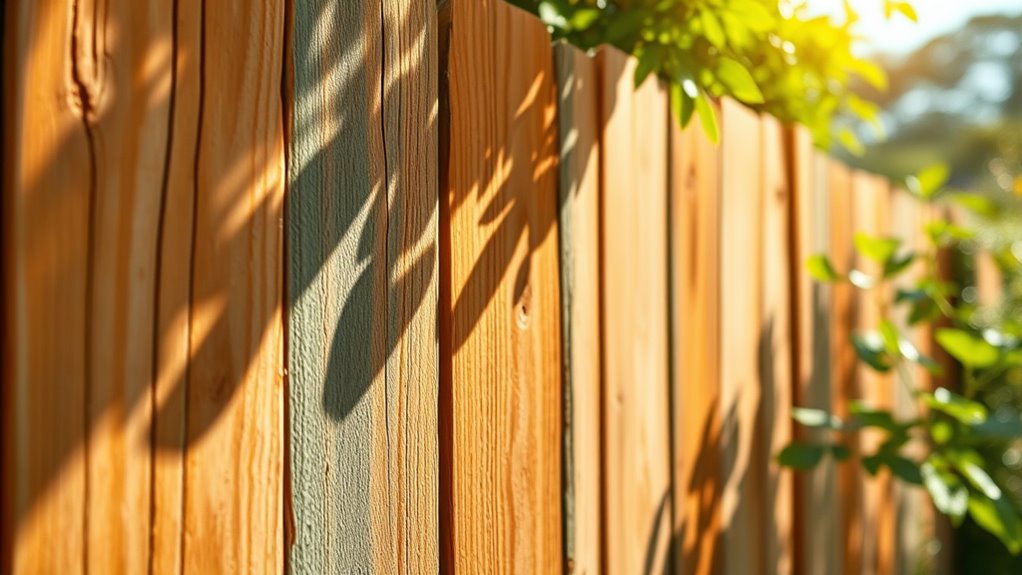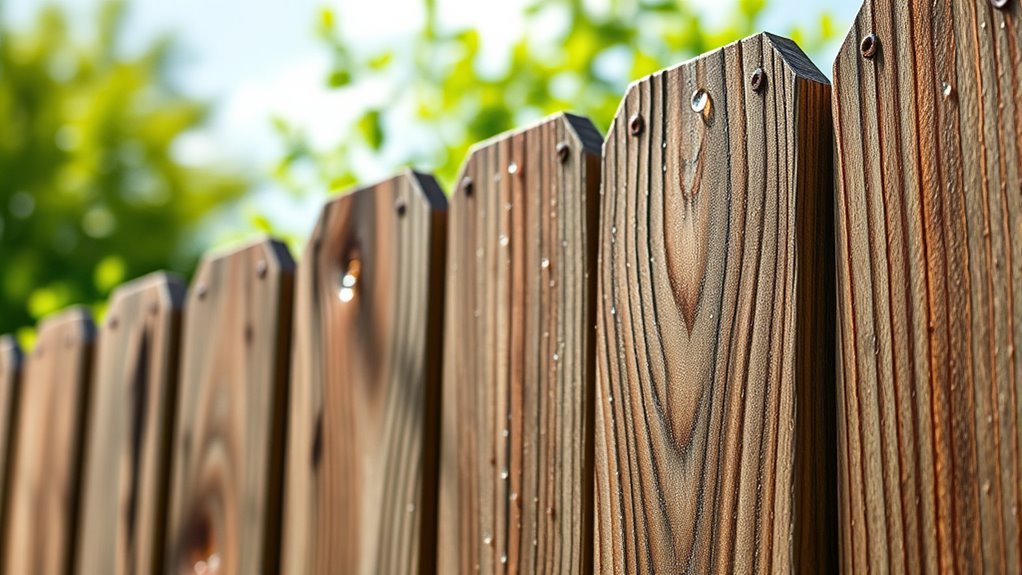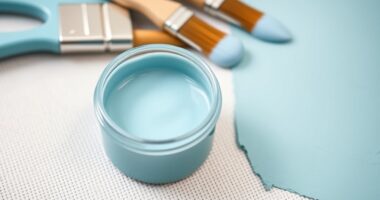To weatherproof outdoor wood and protect against UV damage, start by thoroughly cleaning and sanding the surface. Apply a high-quality primer designed for exterior wood, then use a UV-protected, exterior-grade paint, preferably water-based acrylic for flexibility. For extra durability, add a clear sealant or topcoat. Regular maintenance, such as cleaning and touch-ups, helps prolong the finish. If you keep going, you’ll discover how proper preparation and product choices guarantee long-lasting, weather-resistant results.
Key Takeaways
- Proper surface preparation, including cleaning and light sanding, enhances paint adhesion and weather resistance.
- Use high-quality, UV-protective primer to seal the wood grain and prevent sunlight damage.
- Choose exterior-grade, UV-resistant paints like acrylics for durability and color retention.
- Apply a clear sealant or topcoat for added moisture and UV protection.
- Regular maintenance, cleaning, and touch-ups extend the lifespan of the weatherproofed outdoor wood finish.

Are you wondering how to guarantee your outdoor wood surfaces stay protected and looking their best? The key lies in understanding how to properly prepare and paint your wood to withstand the elements. One of the most important aspects is appreciating the natural wood grain. The wood grain not only adds character and aesthetic appeal but also affects how the paint adheres and performs over time. When you choose the right paint, it should complement and enhance the wood’s natural texture while providing a durable coating that resists peeling, cracking, and fading. This focus on paint durability ensures your outdoor wood looks great longer, even after exposure to sun, rain, and temperature fluctuations.
Before you start painting, it’s essential to prepare the surface properly. Clean off dirt, mold, and old peeling paint. Sand the wood lightly to smooth rough patches and open up the wood grain. This step allows the new coat of paint to penetrate better and adhere more firmly. Applying a high-quality primer designed for outdoor wood is vital. It acts as a barrier, sealing the wood grain and creating an even surface for your paint. A primer also enhances paint durability, making your finish more resistant to weather and UV damage. Choosing a primer with UV inhibitors can help prevent the sunlight from breaking down the paint over time, which is especially important for outdoor surfaces.
When selecting your paint, opt for a high-quality, exterior-grade product formulated specifically for wood. Look for paints that offer UV protection — this helps prevent fading and discoloration caused by sun exposure. Water-based acrylics are popular because they provide good elasticity, which accommodates the natural expansion and contraction of wood as temperatures change. They also tend to be more resistant to cracking and peeling, which further enhances paint durability. As you apply the paint, follow the manufacturer’s instructions carefully, applying multiple thin coats rather than one thick layer. This approach ensures an even finish and better protection against weathering.
Finally, to maximize the longevity of your painted outdoor wood, consider applying a clear sealant or topcoat designed for outdoor use. This additional layer acts as a shield against moisture, UV rays, and physical wear. Regular maintenance, such as cleaning and touch-up painting when needed, will also prolong the life of your finish. By paying attention to the wood grain, choosing durable, UV-protected paints, and properly prepping your surface, you’ll enjoy a beautifully protected outdoor wood surface that withstands the elements and keeps its visual appeal for years to come.
Frequently Asked Questions
How Often Should I Reapply Weatherproofing Treatments?
You should reapply weatherproofing treatments every 1 to 3 years, depending on your maintenance schedule and local weather conditions. Keep an eye on the wood’s appearance—if it looks faded, cracked, or peeling, it’s time for a reapplication. Regular inspections help you determine the right reapplication frequency, ensuring your outdoor wood stays protected from moisture, UV rays, and other elements. Staying proactive keeps your wood in great shape longer.
Are There Eco-Friendly UV Protection Options for Outdoor Wood?
Yes, you can choose eco-friendly UV protection options that make you feel good about safeguarding your outdoor wood. Biodegradable coatings and natural oils provide effective UV defense while being gentle on the environment. These options let you preserve the beauty of your wood, protect it from weathering, and reduce your ecological footprint. By opting for natural and biodegradable solutions, you guarantee your outdoor space stays vibrant and sustainable for years to come.
Can I Paint Over Existing Weatherproofed Wood?
Yes, you can paint over existing weatherproofed wood, but first, you need proper surface preparation. Clean the surface thoroughly, remove any peeling or flaking paint, and sand it lightly to guarantee good adhesion. Check paint compatibility by choosing a primer suited for the current finish and the new paint type. This process helps the new coat adhere well and provides ideal weatherproofing and UV protection.
What Are Signs That My Outdoor Wood Needs Re-Coating?
Imagine your outdoor wood fading into the background, with surface discoloration that stubbornly won’t go away. You’ll notice wood deterioration, like splintering or peeling paint, signaling it’s time for a fresh coat. Cracks or flaking paint also reveal the protective layer is worn thin. When these signs appear, don’t delay—re-coating restores durability and keeps your wood looking its best, shielding it from the elements.
Does Paint Color Affect UV Protection Effectiveness?
Yes, paint color affects UV protection effectiveness because darker colors have higher UV absorption, providing better shielding against sun damage. Lighter shades reflect more UV rays, offering less protection. If you want essential UV resistance, choose darker or specially formulated UV-resistant paints. Keep in mind that the paint’s quality and UV inhibitors also play vital roles, so pick a high-quality product designed for outdoor wood to guarantee long-lasting protection.
Conclusion
Now that you’ve learned how to weatherproof and protect outdoor wood, it’s almost like the elements conspired to remind you of the importance of good preparation. As you finish your project, you might notice a sudden breeze or a passing cloud—nature’s subtle nod that your efforts are paying off. With the right paint and a little luck, your wood will stay vibrant and protected, turning this coincidence into a lasting outdoor masterpiece.









